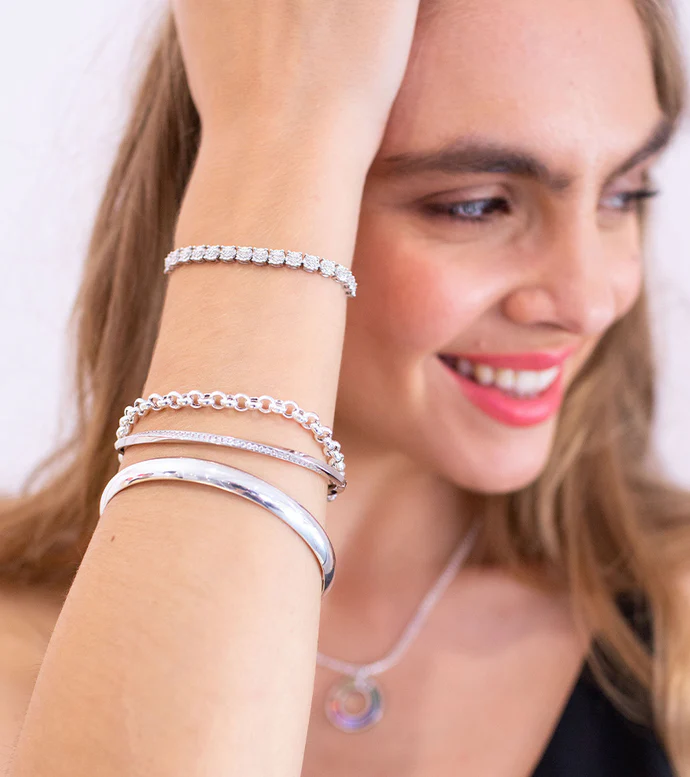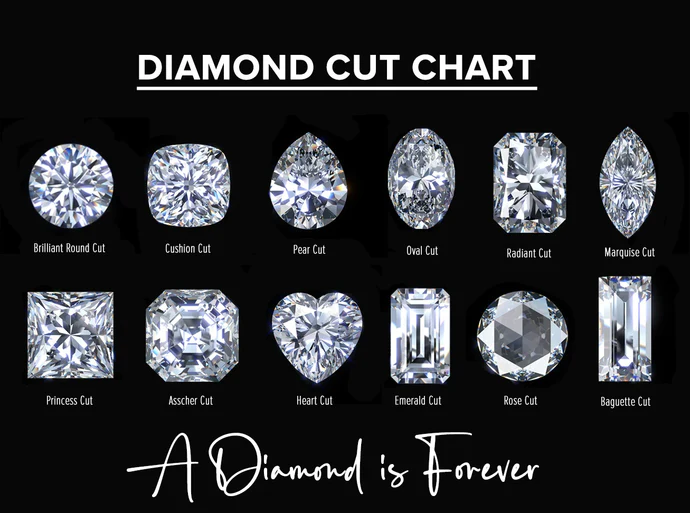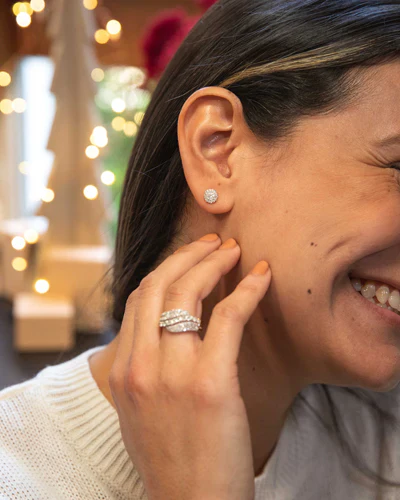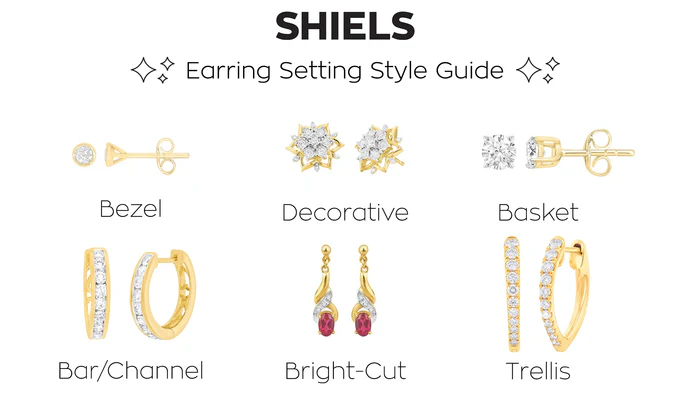Guide To Buying Diamond Earrings
When it comes to building your diamond collection, diamond earrings are often the first choice. They are, after all, the most carefree, versatile and affordable of all the diamond jewellery items. But that is not to say that earrings are not a good diamond investment, as not only do classic diamond earring styles rarely change but they also pretty much go with any outfit or item of jewellery. This makes them a great wardrobe staple with the potential to be in your collection for many years to come.
Whether your pair of earrings stands the test of time, however, is largely down to the research you conduct before making your purchase. There are many things to consider before browsing any jewellery cabinets for your dream pair of earrings and we're not just talking about deciding whether you want a pair of diamond hoops or studs. Fortunately, Shiels' guide to buying diamond earrings is here to make the process of buying diamond earrings much easier. Read on!
- How to buy good diamond earrings
- Cut
- Colour
- Carat
- Clarity
- How to pick diamond earrings
- Style
- Metal
- Budget
- Diamond Type
- How to pick diamond stud earrings
- Setting
- Cut
- Weight
- Allergies
- How to care for diamond earrings
- Clean frequently
- Store properly
- Avoid pools
- Don't sleep in them

HOW TO BUY GOOD DIAMOND EARRINGS
Anyone can buy a pair of diamond earrings, but the right kind of buyer's knowledge determines whether you buy a good pair of diamond earrings or not. A diamond's quality and value will almost always be determined by the four C'scut, colour, carat and clarity. Having a decent understanding of these four things will not only help you understand how to choose diamond earrings, but will also make it easier when making other diamond purchases down the line.

CUT
When people talk about a diamond's cut they are referring to the shape that a diamond is polished into. Every diamond that is set into jewellery will have its own unique cut, whether it be round-cut, emerald-cut, princess-cut, cushion-cut or marquise-cut. Each diamond cut has unique characteristics that not only determine its style but also how well it sparkles. When a diamond is mined from deep within the earth's crust, it looks nothing like how we know them to be when they are set into things like diamond rings and diamond pendants.
Rigid, sharp and nowhere near as sparkly, it is up to a diamond specialist to polish the stone into a particular cut using a steel blade or a laser. When the diamond specialist is working their magic, they will produce what is known as facets. Diamond facets are the flat surfaces present in the shape of a diamond. Refracting a great deal of light, each diamond cut has a specific amount of facets to determine how well a diamond will sparkle. With over 58 facets, round-cut diamonds are often regarded as the most ideal cut, particularly in earrings due to their ability to refract huge fragments of light.

COLOUR
Colour is another aspect that greatly affects a diamond's appearance and value, especially when it comes to diamond earrings. While your eyes may tell a different story, many will be surprised to know that most diamonds are not completely clear or colourless. Often invisible to the naked eye, most white diamonds will have a tinge of yellow or brown to them. In fact, colourless diamonds are extremely rare and will often come with a very hefty price tag to compensate for this.
But while colourless diamonds may be extremely valuable, they are trumped only by vibrantly coloured diamonds known as fancies' that come in all shades of the rainbow including black and pink. When a diamond is priced, jewellers will refer to a diamond colour chart developed by the Gemological Institute of America (GIA) that will grade a stone's hue using an alphabetical system. According to the GIA chart, D, E and F diamonds are the most valuable as they are characterised by being completely colourless with full translucence.

CARAT
An ancient measuring system that was used to determine how many seeds were present in a carob tree, today carat serves a different purpose as the universal measuring system for diamonds. When a diamond is priced, the jeweller will measure the diamond's weight and size to determine how many carats it is. One carat is divided into 100 points and anything less than one carat will be referred to as a pointer'. A diamond's carat weight will greatly affect a diamond's value with stones that are on a larger scale naturally being more expensive.
However, earrings will often have fewer carats compared to items such as rings or diamond necklaces to ensure that they don't weigh down your ears too much. While it is largely dependent on the style of the piece, items such as stud earrings that aren't arranged in a cluster-like setting will often have a single stone that will occasionally be over or close to one carat. Pieces like diamond hoop earrings or drop earrings will often feature an array of pointers that can be a carat or more all up.

CLARITY
A diamond's clarity is pretty cut and dry. During the formation process, many diamonds will accumulate small black specks or hairlines known as inclusions that occur as the result of uncrystallised carbon. Generally hard to spot without any sort of magnifying equipment, it is extremely rare for a diamond to have at least some inclusions but when they do have next to none, they are referred to as a flawless' diamond and are extremely expensive.
So, when shopping for your next pair of diamond earrings, it is a good idea to have somewhat of an understanding of the diamond grading system used to determine a stone's level of inclusions. Especially if having a stone with very few inclusions is important to you. A diamond's clarity is measured using a GIA scale that ranges from F or IF (flawless or internally flawless) to P1 (imperfect). For diamonds under one carat, the average clarity level is VS1 or VS2 (very slightly imperfect).
HOW TO PICK DIAMOND EARRINGS
Once you know the ins and outs of how to buy good diamond earrings, you can then learn how to pick diamond earrings using a more personal approach. From style and metal to budget, there are many factors to consider when choosing diamond earrings outside of the four C's. These factors will help you ascertain what pair of earrings are right for you and will also ensure that whatever pair you choose is sure to stand the test of time.

STYLE
From jazzy hoops to timeless diamond drop earrings, the first thing to consider when choosing earrings is what style you want them to be. Three factors are going to impact the style of earrings you choose:
- The occasion you're going to wear them
- The other jewellery you want to pair them with; and of course
- Your personal preferences
If you are after a pair of earrings that is carefree and suitable for every day including days at the office, you may want to invest in a pair of stud earrings or huggie earrings. But if you are looking for something that you want to keep for dressier formal occasions and other special events, you may wish to pick something a bit more grandiose like a pair of diamond chandelier earrings.

METAL
When choosing the metal you want your earring's setting to be, most people make the decision based on what type of jewellery makes up the bulk of their collection whether it be elegant gold, cool silver or romantic rose gold. However, there is so much more to consider when making this decision, including what kind of metal in your collection you think is going to get the most wear, what ones won't interfere with your sensitive ears and of course, what is the most durable. While most metals used in jewellery are relatively durable, some are more delicate than others.
For one, pure silver earrings are probably not as desirable as sterling silver earrings that contain other metal alloys to make them more durable. However, these alloys don't stop them from tarnishing and can occasionally cause allergic reactions if they contain nickel. Then there are gold earrings which rarely become corroded or tarnished but are often a lot more expensive.

BUDGET
While setting, style and metal are all very important factors, the decider is arguably going to be budget. Because of their size, earrings will often feature very few diamonds, many of which will be relatively small. As a result, you will occasionally pick up a pair of diamond earrings with a very low price tag. But unfortunately, like anything that has diamonds in it, more often than not it is going to get up there in price. Whether you are looking for your forever piece, an extra special gift for a very special person in your life or just a pair that you can whack on every day without much thought to it, your budget is going to impact the type and quality of earrings you can afford.
While some diamond earrings can cost as little as $100, others can range into the thousands, if not hundreds of thousands, depending on their quality and any other additions. If you are looking to save a bit, you could potentially opt for a pair of silver earrings with smaller diamonds or ones with more inclusions. If your budget is a little more flexible or you have your eye on a very special piece, look into yellow gold or white gold earrings with larger stones.

TYPE OF DIAMOND
A more recent debate to arise in relation to purchasing diamond jewellery is the type of diamond that you want to get. Not all diamonds are the same. Wander into any jewellery store and you won't just find mined diamonds; these days, you will also find Lab-Grown Diamonds, Treated Diamonds and Fancy-Coloured Diamonds.
The most traditional of the bunch, mined diamonds are stones that have been sourced directly from the earth's crust. Sometimes over a billion years old, mined diamonds are made out of carbon and are formed due to extreme pressures and temperatures. Generally almost or completely colourless, they are generally more expensive due to being the most sought after. However, man-made or lab-grown diamonds are produced in a controlled laboratory setting that mimics the conditions in which a mined diamond is produced. This makes lab-grown diamonds 25% more affordable than mined diamonds and much more eco-friendly.
Then there are treated diamonds. Although rare, treated diamonds are very similar to treated gemstones in the sense that they contain a special chemical filling that enhances the stone's clarity, making them at least 50% cheaper than their equivalent mined diamonds.
Lastly, there are fancy-coloured diamonds. The holy grail of the bunch, coloured diamonds are the rarest of them all. Coming in all different shades, resulting in everything from flirty pink diamond rings to daring black diamond earrings, coloured diamonds are the result of trace elements interacting with carbon during their formation. Coloured diamonds are arguably the most expensive of all diamonds.
HOW TO PICK DIAMOND STUD EARRINGS
As one of the most highly sought-after earring styles, understanding how to choose diamond stud earrings comes with its own set of challenges. So much so, that many people compare the process of shopping for diamond earrings to looking for diamond dress rings,wedding rings and even engagement rings. From choosing between single stones vs multiple stones to the diamond shape, there is much to remember when picking diamond stud earrings.

SETTING
Much like with a diamond ring, the setting plays a big part in choosing your perfect pair of diamond studs. Naturally, there are tons of settings to pick from. The most common setting choice for diamond studs is the prong setting. Holding your diamond into place with three or four evenly distributed metal prongs, prong settings are a popular choice for single stone earrings as not only are they simple yet comfortable, they also allow the wearer to show off their diamond's sparkle.
The next most popular setting is the bezel setting. Holding the stone or stones into place with a band of metal that surrounds them, many people favour bezel settings since they give the illusion of a bigger diamond. Another earring setting choice that is proving to be popular among shoppers is the crown or basket setting. Often confused with the prong setting, this setting has a flat bottom with the stones often placed on top like a basket.

DIAMOND-CUT
The diamond-cut you choose when picking your stud earrings is extremely important as it impacts the way your diamond sparkles. Earrings are generally small so it can be hard for them to stand out as well as diamond bracelets or rings. But with the right shape, you can ensure your diamond earrings occupy centre stage.
The most popular diamond-cut is the round-cut and that is for a good reason. With over 58 facets, round-cut diamonds give off an immense sparkle. They are also the most versatile and are used in everything from single stone styles and cluster styles to halo style earrings.
There is the subtle yet extremely stylish emerald-cut that will give your diamond jewellery a slightly more art-deco feel. Then there is the princess-cut, which gives off a decent amount of sparkle and can sometimes have a somewhat edgy look, especially when set into rose gold earrings.

ALLERGIES
A majority of people suffer from allergies such as contact dermatitis. Contact dermatitis is a common skin condition that causes some people to come up in welts, rashes and bumps after contact with particular objectsincluding certain metals.
Wearing certain jewellery is one of the biggest culprits for this condition, as many pieces contain nickel, a metal alloy that often accompanies pure gold and silver to make it sturdier. This is why if you suffer from sensitive skin or a nickel allergy, your first line of business is to rule out what metals are unsuitable for your ears and which ones are fine. A general rule of thumb is to avoid cheaper items such as gold-plated jewellery unless they specifically indicate that they don't contain nickel. Generally, the most suitable metals for those with allergies are 925 silver (sterling silver containing 92.5% pure silver), 18-carat yellow gold, stainless steel, nickel-free gold, pure silver or titanium jewellery.
HOW TO CARE FOR DIAMOND EARRINGS
Knowing how to care for diamond earrings properly ensures they stay in an adequate condition for longer. With the proper care and maintenance, you can make sure that your earrings not only stand the test of time but even have the potential to be handed down for future generations to enjoy.
CLEAN THEM FREQUENTLY
With daily wear, earrings often bear the brunt of what life throws at you. With everything from makeup, fake tan and skin creams to dirt, sweat and dust accumulating over time, your earrings can become pretty grotty. As a result, they become vulnerable to tarnishing, corrosion and discolouration. Not to mention, they can aggravate your ears if you are particularly sensitive to skin pollutants.
This is why maintaining and thoroughly cleaning your earrings daily or even weekly after wearing them should be a top priority. Cleaning them is quick, easy and affordable, and doesn't require any trips to the jeweller. All you will need to do is gather a small bowl of warm water, add some dishwashing liquid and allow your earrings to soak in them for around thirty minutes. Once that is done, pat them dry with a soft cloth and voila, your earrings will look good as new!
STORE THEM PROPERLY
How you store your jewellery can directly impact its condition, as things like too much moisture and sunlight can cause certain types of jewellery to become tarnished and corroded. So, when you take off your earrings after a long hard day, refrain from simply leaving them sitting on your bedside table or the bathroom sink. These conditions can be very harmful to your earrings, especially if they are silver.
The best way to store your earrings is in a cool dry spot, preferably in a jewellery box that allows you to separate pieces by metal so that they don't interact with one another. Storing your jewellery this way will not only protect your earrings from environmental factors that can impact their condition, but it will also keep them away from children and pets who can get their hands (or paws) on them and potentially break them or even swallow them.
AVOID POOLS
Earrings in the pool are a big no, no. One reason that you shouldn't wear earrings in the pool is that some of the chemicals present in chlorine can cause the metals in your earring's setting to deteriorate over time.
This is because frequently wearing your gold or silver earrings in the pool can cause them to discolour, while earrings that contain metal alloys such as copper, zinc and nickel can have a chemical reaction that often results in the skin around your ears turning green for a short period.
Another reason why you should leave your earrings at home when you head to the pool is that they could be loose, which means they could fall out of your ears and sink to the bottom of the pool without you noticing.
Try not to sleep in them
While it is tempting to jump into bed after a long hard day with all your jewellery still on, removing it all before bed is another way to ensure its longevity.
Sleeping with earrings is not only uncomfortable, particularly if you are a side-sleeper, but it can also lead to sensitive ears. This is because sleeping on your earrings can put pressure on your ears, especially if they have big heavy diamonds in them. Sleeping with your earrings in can also result in the setting becoming damaged due to being all contorted and bent during your slumber.











